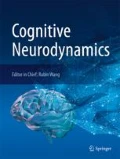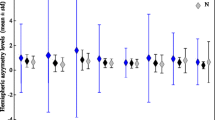Abstract
Recent studies show right hemisphere has a unique contribution to emotion processing. The present study investigated EEG using non-linear measures during emotional processing in PD patients with respect to motor symptom asymmetry (i.e., most affected body side). We recorded 14-channel wireless EEGs from 20 PD patients and 10 healthy age-matched controls (HC) by eliciting emotions such as happiness, sadness, fear, anger, surprise and disgust. PD patients were divided into two groups, based on most affected body side and unilateral motor symptom severity: left side-affected (LPD, n = 10) or right side-affected PD patients (RPD, n = 10). Nonlinear analysis of these emotional EEGs were performed by using approximate entropy, correlation dimension, detrended fluctuation analysis, fractal dimension, higher order spectra, hurst exponent (HE), largest Lyapunov exponent and sample entropy. The extracted features were ranked using analysis of variance based on F value. The ranked features were then fed into classifiers namely fuzzy K-nearest neighbor and support vector machine to obtain optimal performance using minimum number of features. From the experimental results, we found that (a) classification performance across all frequency bands performed well in recognizing emotional states of LPD, RPD, and HC; (b) the emotion-specific features were mainly related to higher frequency bands; and (c) predominantly LPD patients (inferred right-hemisphere pathology) were more impaired in emotion processing compared to RPD, as showed by a poorer classification performance. The results suggest that asymmetric neuronal degeneration in PD patients may contribute to the impairment of emotional communication.



Similar content being viewed by others
References
Acharya UR, Fujita H, Sudarshan VK, Bhat S, Koh JEW (2015) Application of entropies for automated diagnosis of epilepsy using EEG signals: a review. Knowl Based Syst 88:85–96
Adolphs R, Damasio H, Tranel D, Damasio AR (1996) Corticle systems for the recognition of emotion in facial expressions. J Neurosci 16:7678–7687
Ariatti A, Benuzzi F, Nichelli P (2008) Recognition of emotions from visual and prosodic cues in Parkinson’s disease. Neurol Sci 29:219–227
Beck AT, Ward CH, Mendelson M, Mock J, Erbaugh J (1961) An inventory for measuring depression. Arch Gen Psychiatry 4:561–571
Bleton H, Sejdic E (2015) A cerebral blood flow evaluation during cognitive tasks following a cervical spinal cord injury: a case study using transcranial Doppler recordings. Cogn Neurodyn 9:615–626
Chandran V, Elgar SL (1993) Pattern recognition using invariants defined from higher order spectra-one dimensional inputs. IEEE Trans Signal Process 41:205–212
Chua KC, Chandran V, Acharya UR, Lim CM (2010) Application of higher order statistics/spectra in biomedical signals-A review. J Med Eng Phys 32:679–689
Clark US, Neargarder S, Cronin-Golomb A (2008) Specific impairments in the recognition of emotional facial expressions in Parkinson’s disease. Neuropsychologia 46:2300–2309
Fahn S, Elton RL, Committee M (1987) Unified Parkinson’s Disease Rating Scale. In: Fahn S, Marsden CD, Calne DB, Goldstein M, Clane DB (eds) Recent developments in Parkinson’s Disease Macmillan health care information, vol 2. Florham Park, New Jersey, pp 53–163
Folstein MF, Folstein SE, Mchugh PR (1975) Mini-Mental State Examination: a practical method for grading the cognitive state of patients. Psychol Res 12:189–198
Garrido-Vásquez P, Pell MD, Paulmann S, Strecker K, Schwarz J, Kotz SA (2013) An ERP study of vocal emotion processing in asymmetric Parkinson’s disease. Soc Cogn Affect Neurosci 8:918–927
Gotlib IH, Raganathan C, Rosenfeld JP (1998) Frontal EEG alpha asymmetry, depression, and cognitive functioning. Cogn Emot 12:449–478
Grassberger P, Procassia I (1983) Measuring the strangeness of strange attractors. Phys D 9:189–208
Gray HM, Tickle-Degnen L (2010) A meta-analysis of performance on emotion recognition tasks in parkinson’s disease. Neuropsychology 24:176–191
Hadjidimitriou SK, Hadjileontiadis LJ (2012) Toward an EEG-based recognition of music liking using time-frequency analysis. IEEE Trans Biomed Eng 59:3498–3510
Hamdi H, Richard P, Suteau A, Allain P (2012) Emotion assessment for affective computing based on physiological responses. In: IEEE proceedings of world congress on computational intelligence, pp 10–15
Han CX, Wang J, Yi GS, Che YQ (2013) Investigation of EEG abnormalities in the early stage of Parkinson’s disease. Cogn Neurodyn 7:351–359
Higuchi T (1988) Approach to an irregular time series on the basis of the fractal theory. Phys D 31:277–283
Hoehn MM, Yahr MD (1967) Parkinsonism: onset progression and mortality. Neurology 17:427–442
Jeong J, Kim SY, Han SH (1998) Non-linear dynamical analysis of the EEG in Alzheimer’s disease with optimal embedding dimension. Electroencephalogr Clin Neurophysiol 106:220–228
Katz MJ (1998) Fractals and the analysis of waveforms. Comput Biol Med 18:145–156
Kobayashi H, Mark BL, Turin W (2011) Probabaility, random processes and statistical analysis: applications to communications, Signal processing queueing theory and mathematical finance. Cambridge University Press, Cambridge
Kober H, Barrett LF, Joseph J, Bliss-Moreau E, Lindquist K, Wagera TD (2008) Functional grouping and cortical–subcortical interactions in emotion: a meta-analysis of neuroimaging studies. Neuroimage 42:998–1031
Lawrence AD, Goerendt IK, Brooks DJ (2007) Impaired recogition of facial expression of anger in Parkinson’s disease patients acutely withdrawn from dopamine replacement theraphy. Neuropsychologia 45:65–74
Liu X et al (2015) Multiple characteristics analysis of Alzheimer’s electroencephalogram by power spectral density and Lempel–Ziv complexity. Cogn Neurodyn 1–13
Luo Q, Holroyd T, Jones M, Hendler T, Blair J (2007) Neural dynamics for facial threat processing as revealed by gamma band synchronization using MEG. Neuroimage 34:839–847
Oldfield RC (1971) The assessment and analysis of handedness: the Edinburgh inventory. Neuropsychologia 9:97–113
Oya H, Kawasaki H, Howard MA, Adolphs R (2002) Electrophysiological responses in the human amygdala discriminate emotion categories of complex visual stimuli. J NeuroSci 22:9502–9512
Pell MD, Baum SR (1997) Unilateral brain damage, prosodic comprehension deficits, and the acoustic cues to prosody. Brain Lang 57:195–214
Peng CK, Havlin S, Stanley HE, Goldberger AL (1995) Quantification of scaling exponents and crossover phenomena in nonstationary heartbeat time series Chaos: interdisciplinary. J Nonlinear Sci 5:82–87
Péron J, Dondaine T, Jeune FL, Grandjean D, Vérin M (2012) Emotional processing in Parkinson’s disease: a systematic review. Mov Disord 27:186–199
Picard RW, Vyzas E, Healey J (2001) Toward machine emotional intelligence: analysis of affective physiological state. IEEE Trans Pattern Anal Mach Intell 23:1175–1191
Pincus SM, Goldberger AL (1994) Physiological time-series analysis: what does regularity quantify? Am J Physiol 266(4 Pt 2):H1643–H1656
Poppy PLS, Speckens AE (2015) Multi-dimensional modulations of α and γ cortical dynamics following mindfulness-based cognitive therapy in major depressive disorder. Cogn Neurodyn 9:13–29
Rosenstein MT, Collins JJ, Luca CJD (1993) A practical method for calculating largest Lyapunov exponents from small data sets. Phys D Nonlinear Phenom 65:117–134
Sammler D, Grigutsch M, Fritz T, Koelsch S (2007) Music and emotion: electrophysiological correlates of the processing of pleasant and unpleasant music. Psychophysiology 44:293–304
Schröder C et al (2006) Perception of emotional speech in Parkinson’s disease. Mov Disord 21:1774–1778
Stam CJ (2005) Nonlinear dynamical analysis of EEG and MEG: review of an emerging field. Clin Neurophysiol 116:2266–2301
Subha DP, Joseph PK, Acharya UR, Lim CM (2010) EEG signal analysis: a survey. J Med Syst 34:195–212
Valenza G, Lanata A, Scilingo EP (2012) The role of nonlinear dynamics in affective valence and arousal recognition. IEEE Trans Affect Comput 3:237–249
VanLancker D, Sidtis JJ (1992) The identification of affective, prosodic stimuli by left and right-hemisphere damaged subjects: all errors are not created equal. J Speech Hear Res 35:963–970
Ventura MI, Baynes K, Sigvardt KA, Unruh AM, Acklin S, Kirsch HE, Disbrow EA (2012) Hemispheric asymmetries and prosodic emotion recognition deficits in Parkinson’s disease. Neuropsychologia 50:1936–1945
Verma GK, Tiwary US (2014) Multimodal fusion framework: a multiresolution appraoch for emtotion classification and recognition from physiological signals. Neuroimage 102:162–172
Wieser MJ, Muhlberger A, Alpers G, Macht M, Ellgring H, Pauli P (2006) Emotion processing in parkinson’s disease: dissociation between early neuronal processing and explicit ratings. Clin Neurophysiol 117:94–102
Yip JT, Lee TM, Ho SL, Tsang KL, Li LS (2003) Emotion recognition in patients with idiopathic Parkinson’s disease. Mov Disord 18:1115–1122
Yuvaraj R, Murugappan M, Norlinah MI, Sundaraj K, Khairiyah M (2013) Review of emotion recognition in stroke patients. Dement Geriatr Cogn Disord 36:179–196
Yuvaraj R et al (2014a) Inter-hemispheric EEG coherence analysis in Parkinson’s disease: assessing brain activity during emotion processing. J Neural Transm 122:237–252
Yuvaraj R, Murugappan M, Norlinah MI, Sundaraj K, Omar MI, Khairiyah M, Palaniappan R (2014b) Optimal set of EEG features for emotional state classification and trajectory visualization in Parkinsosn’s disease. Int J Psychophysiol 94:482–495
Acknowledgments
This research was financially supported by Fundamental Research Grant Scheme (FRGS), Ministry of Higher Education, Malaysia. Grant No: 9003-00507.
Author information
Authors and Affiliations
Corresponding author
Rights and permissions
About this article
Cite this article
Yuvaraj, R., Murugappan, M. Hemispheric asymmetry non-linear analysis of EEG during emotional responses from idiopathic Parkinson’s disease patients. Cogn Neurodyn 10, 225–234 (2016). https://doi.org/10.1007/s11571-016-9375-3
Received:
Revised:
Accepted:
Published:
Issue Date:
DOI: https://doi.org/10.1007/s11571-016-9375-3




